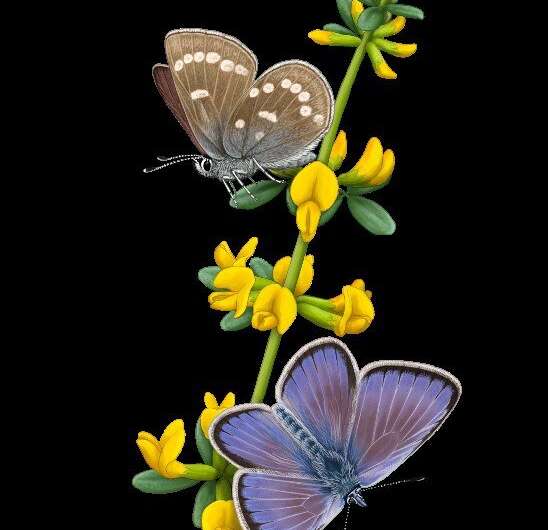This article has been reviewed according to Science X's editorial process and policies. Editors have highlighted the following attributes while ensuring the content's credibility:
fact-checked
peer-reviewed publication
trusted source
proofread
An icon of anthropogenic extinction: Xerces Blue butterfly genome sequenced

The Xerces Blue butterfly (Glaucopsyche xerces) was native to the coastal dunes of San Francisco, in the United States. As the city grew, much of the butterfly's habitat was destroyed and its population was relegated to Golden Gate National Park. Its wings were a deep iridescent blue, with characteristic white spots on the ventral side.
The last surviving specimens of the species were found in 1941, by entomologist W. Harry Lange. It is considered the first insect species to have become extinct in historical times. Its disappearance has made it a global icon of anthropogenic extinction, to the extent that it has given its name to a famous American conservation association, the Xerces Society.
A previous study in 2022 recovered mitochondrial DNA from a specimen of the Xerces Blue butterfly and compared it to that of the Silvery Blue butterfly (Glaucopsyche lygdamus), its closest living relative, concluding that they were indeed distinct species and not just different populations.
The research was led by Carles Lalueza-Fox, director of the MCNB and researcher at the IBE (CSIC-UPF), and Roger Vila, researcher at the IBE (CSIC-UPF), with the participation of Tomàs Marquès-Bonet, ICREA researcher at the Department of Medicine and Sciences of Life (MELIS) of the Pompeu Fabra University and the IBE and Professor of the same university.
Their work, published in eLife, has successfully sequenced the genomes of four Xerces Blue butterflies and seven Silvery Blue butterflies between 80 and 100 years old from the Smithsonian Institution in Washington. Researchers have been able to infer that the two species diverged between one and two million years ago and that they represent two distinct evolutionary lineages.
A comparison of the genomes of the two species revealed that the DNA of the Xerces Blue butterfly showed a high incidence of inbreeding, a sign of population decline that could be used to identify other insect species threatened by human activity and whose extinction patterns, unlike those of vertebrates, are currently not well known. It could also pave the way towards the de-extinction of this popular butterfly, a project that has been of interest to the scientific community for many years.
The Xerces Blue genome reveals its extinction story
The research results indicate that the Xerces Blue butterfly experienced a major population decline over tens of thousands of years, probably brought about by climate changes that did not affect the Silvery Blue. The destruction of its habitat by humans, however, triggered its eventual extinction.
This is the conclusion of the study after finding traits in its genome that are typical of a small population, including low genetic diversity, long chromosomal fragments with no genetic variation and a high frequency of deleterious alleles, which impaired the viability of individuals and made it what we would now term a vulnerable species.
Genomic clues could save other endangered insects
The Xerces Blue butterfly is an icon of insect extinction across the globe. Now its genome could help prevent the extinction of other endangered insects whose steep population declines are not immediately obvious.
"Detecting endangered mammalian species is easier, because in many cases it is possible to count individuals," explains Roger Vila, the IBE researcher (CSIC-UPF) who co-led the research.
"However, there are many endangered insects whose status goes unnoticed because it is extremely difficult to census their populations, which generally seem to us to be very abundant. Nevertheless, they can be very sensitive to climate variations and human action, for example, to pesticides. For this reason, we believe that the genomic traits signaling the decline of the Xerces butterfly population could serve as a warning, and help us to detect vulnerable insects in future studies."
Knowing the whole genome is the first step towards de-extinction
The disappearance of insects, especially pollinators, is a very serious global ecological problem. The de-extinction of species such as the Xerces Blue butterfly, using genetic engineering techniques based on CRISPR, is therefore of enormous interest to the scientific community.
"The Xerces Blue butterfly is an excellent candidate for de-extinction because it is an insect that disappeared relatively recently, so the ecological impact of its reappearance is reduced, and there is no risk of pests or excessive proliferation due to the limited time of appearance of the adults (between March and April) and their ecological specialization. We therefore hope that having its complete genome may help in future de-extinction initiatives," indicates Carles Lalueza-Fox, an IBE (CSIC-UPF) researcher and director of the Natural Sciences Museum in Barcelona, who co-led the study.
More information: Toni de-Dios et al, Whole-genomes from the extinct Xerces Blue butterfly can help identify declining insect species, eLife (2023). DOI: 10.7554/eLife.87928.1
Journal information: eLife
Provided by Spanish National Research Council


















